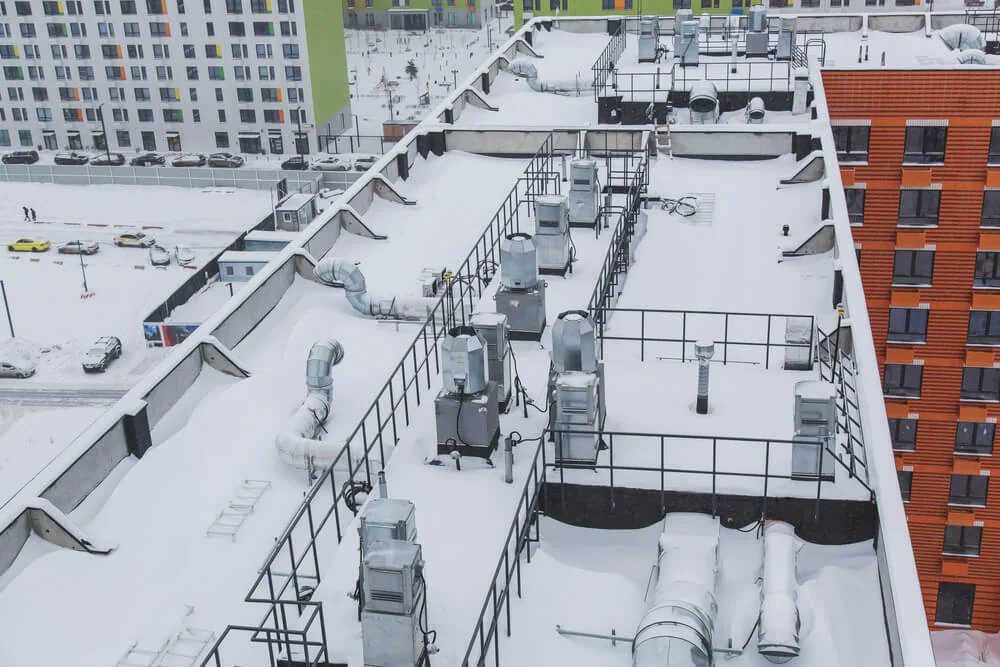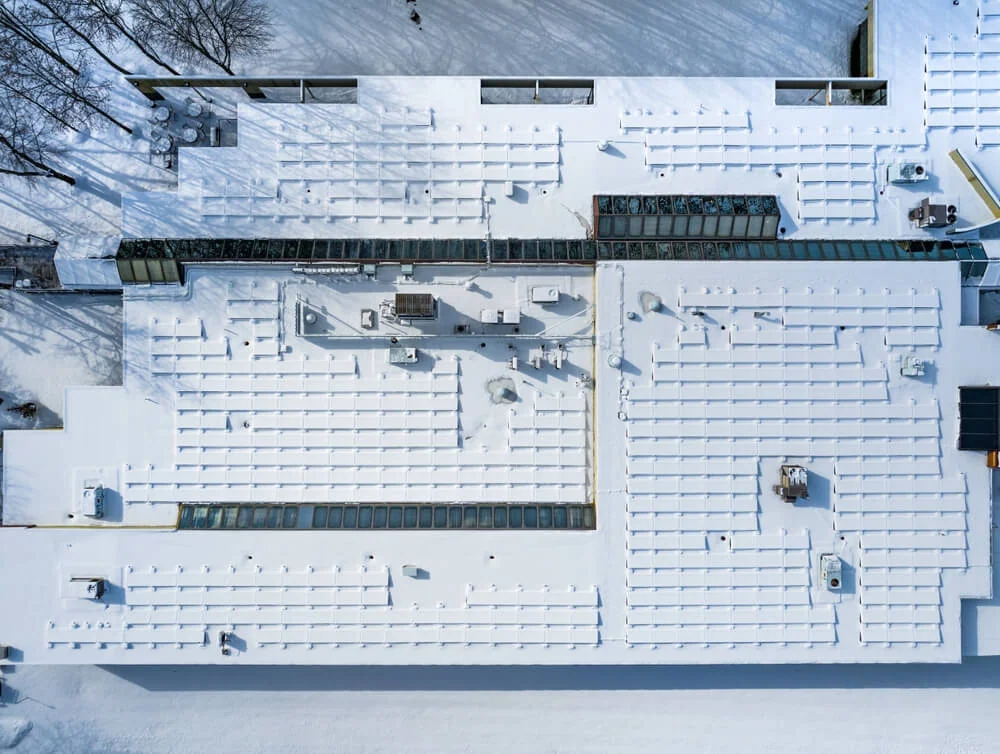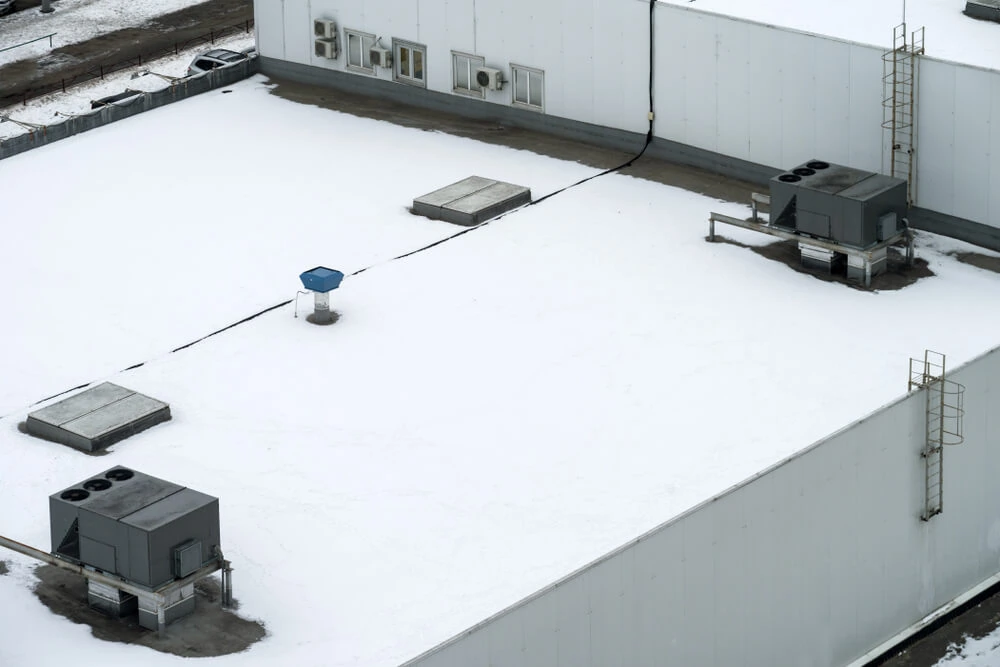Depending on your region, winters can be absolutely brutal on commercial roofs. All of a roof’s weaknesses are pointed out, whether it be an aging membrane, poor maintenance, clogged drains and downspouts, or several other common issues. Preparing your roof to withstand those conditions is one of the most important preventive maintenance tasks a building owner should do. The goal is to avoid emergency and expensive repairs by ensuring your roof is ready for cold weather. This guide will list some of the top tips to prepare your commercial roof for winter.
Understanding the Importance of Winter Preparation
Winter is hard on almost all exterior surfaces, so it’s not that commercial roofing can’t handle them. But, the cold temperatures can lead to costly repairs and potentially dangerous situations. Snow, ice, freezing temperatures, and the daily freeze-thaw cycle can all cause their fair share of damage. That’s why it’s important to inspect a commercial roof and adopt a maintenance schedule to help identify potential issues and address them before the winter weather arrives.
And this schedule of inspection and maintenance isn’t just about surviving a few months each year. It also prolongs the commercial roofing surface’s life by addressing small issues and damage before they turn into bigger, more expensive issues. Also, keeping a roofing system working properly helps improve the building’s overall energy efficiency and reduce heating costs when the temperatures drop.

How Winter Weather Impacts Your Commercial Roof
There are several ways that winter can cause damage to your commercial roof, and each can lead to significant damage if not handled correctly.
- Heavy Snow and Ice Accumulation: As snow and ice accumulate on a roof, their weight begins to increase, leading to potential tearing of the membrane, structural stress, or even a potential collapse. Snow and ice can also block drain systems, causing melted snow to pool on the roof surface, increasing the risk of leaks and damage.
- Freezing Temperatures: Most roofing membranes and materials become less pliable in colder temperatures. Depending on your roof’s condition, it can start to become brittle, causing tears or leaks. And, should winter wind gusts begin to lift the membrane, the entire membrane can separate and leave the roofing deck bare.
- Melting Snow and Ice: Melting snow and ice is always a concern with roofing of any type, but specifically with commercial roofing. If the roof’s drains are clogged, water can refreeze and cause an ice dam, which pushes water back onto the roof and causes pooling. Pooling can lead to leaks and water damage.
Pre-Winter Inspection and Maintenance Tips
The trick is to be proactive about your roof preparation before winter in order to avoid being reactive during an emergency. A thorough roof inspection should be performed over the entire roof, with the inspector on the hunt for signs of excessive wear, damage, deterioration, or other issues that would potentially worsen over the winter season. Making the repairs now, while the weather is still pleasant, will help avoid those problems.
Roof Inspection Checklist
It all starts with a comprehensive commercial roof inspection. Here’s what to look for:
- Check for Damaged or Missing Shingles, Tiles, or Other Roofing Materials: Depending on your roof material, be sure to check for any cracked, curled, torn, or missing sections of shingles, tiles, or roofing membrane.
- Inspect Flashing and Sealants: Inspect any of the caulk and flashing around joists and penetrations. Look at vents, skylights, exhaust fans, and other areas, keeping an eye out for signs of wear, corrosion, shrinking, gaps, and other issues.
- Check for Signs of Animal Infestation or Debris Accumulation: Keep an eye out for animal infestations, as these typically-outside animals often try to make their way in when it gets colder. Also, remove any debris like leaves, branches, and even algae that could be collected on the roof and clog gutters or drain paths.
Preventing Leaks and Water Damage
One of a commercial roof’s main jobs is to prevent water from penetrating the building and causing damage. Make sure any gaps and cracks are sealed to ensure the membrane can keep water out and let it travel through the drainage system and away from the building.
Gaps and cracks need a professional-grade sealant to seal out any water. Make sure that any sealant used is compatible with the roofing materials. Also, clear gutters and downspouts of debris to ensure water flows freely off the roof. Clogged gutters can cause water to back up onto the roof, leading to leaks and ice dams. Finally, inspect any seams between sheets of membrane to ensure they’re adhered and repair them as necessary.
Managing Snow and Ice
Snow and ice are two of the main winter hazards, so have a snow and ice removal plan to manage them. It’s important to remove snow accumulation regularly to prevent too much weight on the membrane and structure underneath. Removing the snow will lighten the load but also help avoid excessive ice accumulation, allowing any water to drain.
When removing snow, it’s important to be safe, both for the building’s sake and your own by:
- Using a snow-melt system to melt the snow on the roof.
- Avoiding any corrosive spreads like salt that can damage the roofing membrane.
- Avoiding snowblowers or shovels, as these tools are best left to experts with the experience necessary to avoid causing damage.
Also, ensure that any downspouts and drains are clear and flowing. Planning for these challenges will ensure you have the materials and equipment necessary when the snow does fall.

Ensuring Proper Insulation
Don’t forget to consider insulation. Poor insulation can allow heat to escape the building, melting the snow over top. As the water runs down and reaches areas that are properly insulated, the surface is colder and refreezes the water. That’s when ice dams form, causing pooling which will eventually lead to leaks.
If there are areas of your building where heat is readily escaping and causing ice dams, consider replacing the insulation. This will improve your building’s overall energy efficiency and prevent potential ice dams.
Additional Tips for Winter Preparation
Here are some other helpful tips to consider when preparing your commercial roof for winter:
- Clear Roof Drains and Gutters: If your building has gutters, they need to be clean to avoid backups and damage to the side of your building. Ensure all drainage components are functioning properly to prevent water accumulation.
- Inspect and Repair Downspouts: Check downspouts for damage and clogging. Make sure they’re properly connected and aren’t leaking, as they should direct water away from the building’s foundation.
- Regular Maintenance and Repairs: Stay on top of your regular roof maintenance tasks throughout the year to extend the life of your roof.
When to Call a Professional
While some maintenance tasks can be performed by building staff, certain signs indicate that it’s time to call a professional roofing contractor.
- Water Damage or Roof Leaks: If you notice water stains on the ceiling or walls, it could indicate a roof leak that requires professional attention.
- Structural Damage or Roof Collapse: Any signs of structural damage, such as sagging or cracks, should be addressed by a professional immediately.
- Signs of Animal Infestation or Debris Accumulation: If animals have taken up residence on your roof or if debris has accumulated, a professional can help remove these hazards safely.
Contact Nations Roof to Prepare Your Commercial Roof
Let’s be honest: getting a commercial roof ready for the winter weather is a big task. Contact Nations Roof today and let us maintain your roof and manage your snow removal plan. We have the experience necessary to manage all of your commercial roof maintenance needs, including their warranty. And, if your roof can’t be repaired, we’ll help you install a new roof and protect your building from water damage. We’re your premier commercial roofing contractor, so contact us today.



